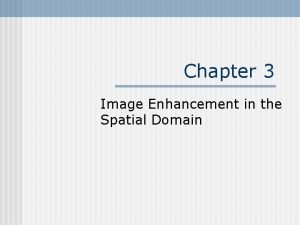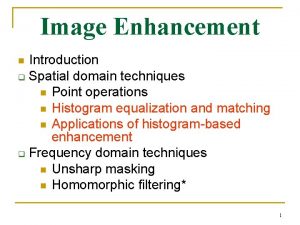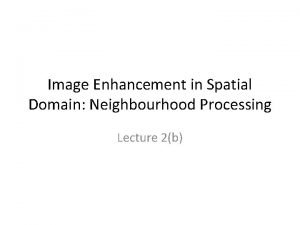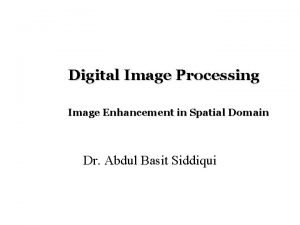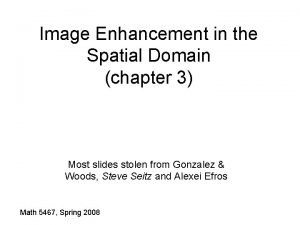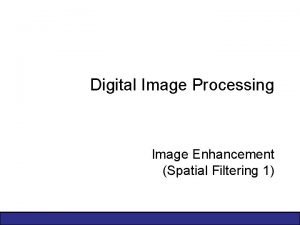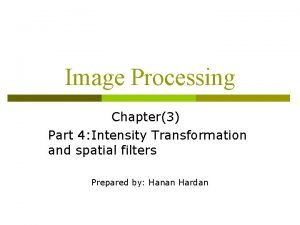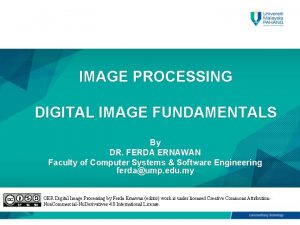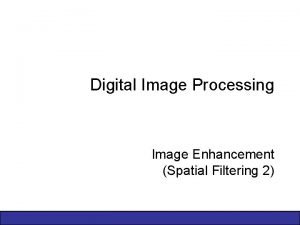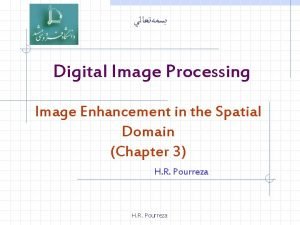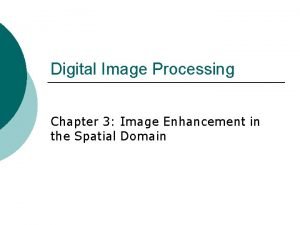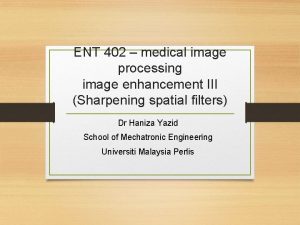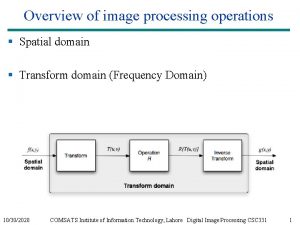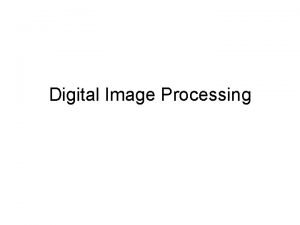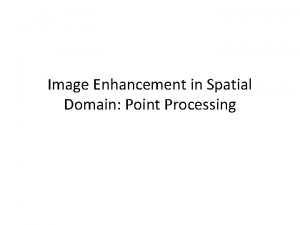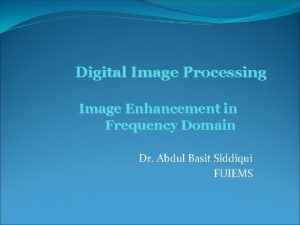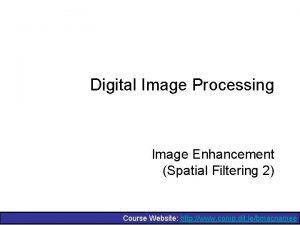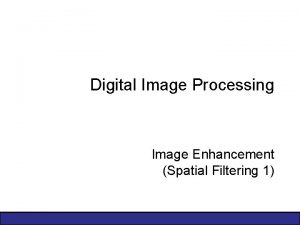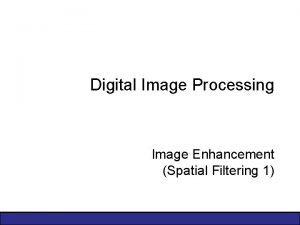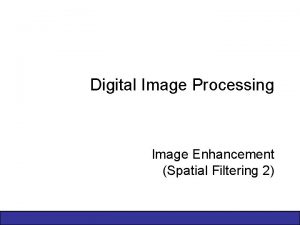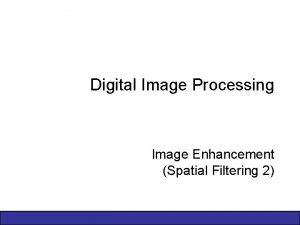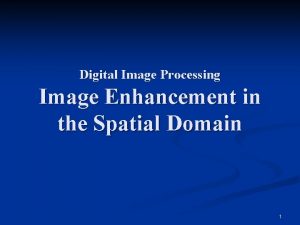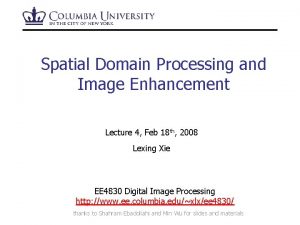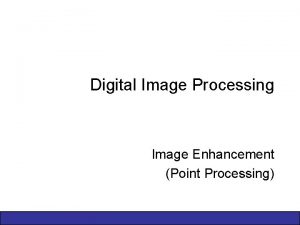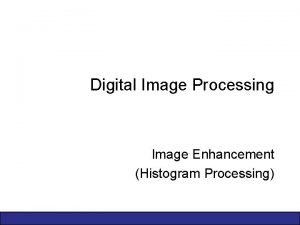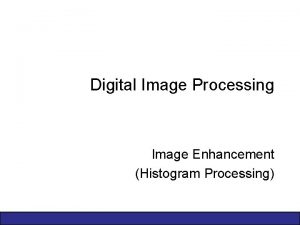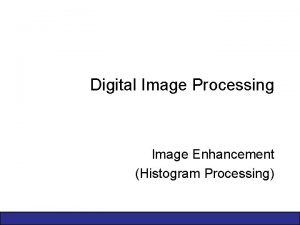Digital Image Processing Image Enhancement in Spatial Domain






![Basic Concepts Spatial domain enhancement methods can be generalized as g(x, y)=T[f(x, y)] f(x, Basic Concepts Spatial domain enhancement methods can be generalized as g(x, y)=T[f(x, y)] f(x,](https://slidetodoc.com/presentation_image_h/c5c88858b10df66476b7bf9c24afc6d3/image-7.jpg)



![Basic Concepts g(x, y) = T [f(x, y)] Pixel/point operation: Neighborhood of size 1 Basic Concepts g(x, y) = T [f(x, y)] Pixel/point operation: Neighborhood of size 1](https://slidetodoc.com/presentation_image_h/c5c88858b10df66476b7bf9c24afc6d3/image-11.jpg)




















- Slides: 31

Digital Image Processing Image Enhancement in Spatial Domain Dr. Abdul Basit Siddiqui

Image Sampling and Quantization • To create a digital image, we need to convert the continuous sensed data into digital form --> this involves sampling and quantization • Digitizing the coordinate values is called sampling • Digitizing the amplitude values is called quantization ---> see Fig. 2. 16 in the textbook • In practice, the method of sampling is determined by the sensor arrangement used to generate the image • The quality of a digital image is determined by the number of samples and the number of gray levels 11/30/2020 2

Spatial resolution and intensity resolution • Sampling is the principal factor defining the spatial resolution of an image, and quantization is the principal factor defining the intensity resolution • Spatial resolution - number of rows and columns for example: 128 x 128, 256 by 256, etc. ; -->see Figs. 2. 19 and 2. 20 • Intensity resolution - number of gray levels for example: 8 bits, 16 bits, etc. ; --->see Fig. 2. 21 11/30/2020 3

Image Enhancement 11/30/2020 4

Image Enhancement Process an image to make the result more suitable than the original image for a specific application –Image enhancement is subjective (problem /application oriented) Image enhancement methods: Spatial domain: Direct manipulation of pixel in an image (on the image plane) Frequency domain: Processing the image based on modifying the Fourier transform of an image Many techniques are based on various combinations of methods from these two categories 11/30/2020 5

Image Enhancement 11/30/2020 6
![Basic Concepts Spatial domain enhancement methods can be generalized as gx yTfx y fx Basic Concepts Spatial domain enhancement methods can be generalized as g(x, y)=T[f(x, y)] f(x,](https://slidetodoc.com/presentation_image_h/c5c88858b10df66476b7bf9c24afc6d3/image-7.jpg)
Basic Concepts Spatial domain enhancement methods can be generalized as g(x, y)=T[f(x, y)] f(x, y): input image g(x, y): processed (output) image T[*]: an operator on f (or a set of input images), defined over neighborhood of (x, y) Neighborhood about (x, y): a square or rectangular sub-image area centered at (x, y) 11/30/2020 7

Point Processes • Point processes are the simplest of basic image processing operations. • A point operation takes a single input image into a single output image in such a way that each output pixel's gray level depends only upon the gray level of the corresponding input pixel. • Thus, a point operation cannot modify the spatial relationships within an image. • Point operations transform the gray scale of an image. 11/30/2020 8

Point Processes • Linear and nonlinear point operations • Examples: – – – Contrast Stretching Image Negatives Intensity-level Slicing Bit-plane Slicing Other Intensity Transformations Histogram Equalization 11/30/2020 9

Basic Concepts 11/30/2020 10
![Basic Concepts gx y T fx y Pixelpoint operation Neighborhood of size 1 Basic Concepts g(x, y) = T [f(x, y)] Pixel/point operation: Neighborhood of size 1](https://slidetodoc.com/presentation_image_h/c5c88858b10df66476b7bf9c24afc6d3/image-11.jpg)
Basic Concepts g(x, y) = T [f(x, y)] Pixel/point operation: Neighborhood of size 1 x 1: g depends only on f at (x, y) T: a gray-level/intensity transformation/mapping function Let r = f(x, y) s = g(x, y) r and s represent gray levels of f and g at (x, y) Then s = T(r) Local operations: g depends on the predefined number of neighbors of f at (x, y) Implemented by using mask processing or filtering Masks (filters, windows, kernels, templates) : a small (e. g. 3× 3) 2 -D array, in which the values of the coefficients determine the nature of the process 11/30/2020 11

Common Pixel Operations § Image Negatives § Log Transformations § Power-Law Transformations 11/30/2020 12

Image Negatives § Reverses the gray level order § For L gray levels the transformation function is s =T(r) = (L - 1) - r 11/30/2020 13

Image Negatives 11/30/2020 14

Image Scaling s =T(r) = a. r (a is a constant) 11/30/2020 15

Log Transformations Function of s = c. Log(1+r) 11/30/2020 16

Log Transformations Properties of log transformations –For lower amplitudes of input image the range of gray levels is expanded –For higher amplitudes of input image the range of gray levels is compressed Application: – This transformation is suitable for the case when the dynamic range of a processed image far exceeds the capability of the display device (e. g. display of the Fourier spectrum of an image) – Also called “dynamic-range compression / expansion” 11/30/2020 17

Log Transformations 11/30/2020 18

Power-Law Transformation 11/30/2020 19

Power-Law Transformation For γ < 1: Expands values of dark pixels, compress values of brighter pixels For γ > 1: Compresses values of dark pixels, expand values of brighter pixels If γ=1 & c=1: Identity transformation (s = r) A variety of devices (image capture, printing, display) respond according to power law and need to be corrected Gamma (γ) correction The process used to correct the power-law response phenomena 11/30/2020 20

Power-Law Transformation 11/30/2020 21

Gamma Correction 11/30/2020 22

Histogram • Gray level histogram of an image - a function showing for each gray level the number of • pixels in the image that have that gray level; it is simply a bar graph of the pixel intensities 11/30/2020 23

Histogram • Histogram gives us a convenient, easy-to-read representation of concentration of pixels versus intensity in an image • Dynamic range - an range of intensity values that occur in an image • Contrast stretching - if image has low-dynamic range; low-dynamic range can result from poor illumination, lack of dynamic range in imaging sensor, wrong setting of the sensor parameters, etc. • Compression of dynamic range - if the dynamic range of the image far exceeds the capability of the display device 11/30/2020 24

Histogram calculation 11/30/2020 25

Examples of several types of image histograms: 11/30/2020 26

Histogram Equalization • Images with poor intensity distributions can often be enhanced with histogram equalization <-- point process • The goal is to obtain a uniform histogram • • Histogram equalization will not flatten a histogram; if a histogram has peaks and valleys it will still have them after equalization - they will be shifted and spread over the entire range of image intensities • Works best on images with fine details in darker regions • Use it carefully - good images can be often degraded by histogram equalization 11/30/2020 27

11/30/2020 28

11/30/2020 29

Histogram of the equalized image 11/30/2020 30

Histogram Equalization-Example 11/30/2020 31
 Image enhancement in spatial domain
Image enhancement in spatial domain Image enhancement in spatial domain
Image enhancement in spatial domain Image enhancement in spatial domain
Image enhancement in spatial domain Image enhancement in spatial domain
Image enhancement in spatial domain What is enhancement in the spatial domain?
What is enhancement in the spatial domain? Digital image processing
Digital image processing Intensity transformation and spatial filtering
Intensity transformation and spatial filtering Image compression models in digital image processing
Image compression models in digital image processing Spatial resolution in digital image processing
Spatial resolution in digital image processing Fractal
Fractal Histogram processing in digital image processing
Histogram processing in digital image processing Neighborhood averaging in image processing
Neighborhood averaging in image processing A generalization of unsharp masking is
A generalization of unsharp masking is What is point processing in digital image processing
What is point processing in digital image processing Morphological
Morphological Combining spatial enhancement methods
Combining spatial enhancement methods Mask mode radiography
Mask mode radiography Iii image inhancement
Iii image inhancement Combining spatial enhancement methods
Combining spatial enhancement methods Idl medical ent
Idl medical ent Image transform in digital image processing
Image transform in digital image processing Optimum notch filter in digital image processing
Optimum notch filter in digital image processing Image segmentation in digital image processing
Image segmentation in digital image processing Error free compression
Error free compression Image sharpening and restoration
Image sharpening and restoration Geometric transformation in digital image processing
Geometric transformation in digital image processing Zooming and shrinking in digital image processing
Zooming and shrinking in digital image processing Image transform in digital image processing
Image transform in digital image processing Maketform
Maketform Image restoration in digital image processing
Image restoration in digital image processing Spatial operations in image processing
Spatial operations in image processing Spatial data vs non spatial data
Spatial data vs non spatial data
